Abstract
1 Miniature endplate currents were recorded with extracellular electrodes in mouse diaphragms in order to measure the kinetics of the conductance change produced by acetylcholine. Miniature endplate potentials (m.e.p.ps) were recorded intracellularly in the same fibres in which the currents were being recoreded. 2 The general anaesthetics, ether, halothane, chloroform and enflurane at low (anaesthetic) concentrations increased the rate of decay of miniature endplate currents (m.e.p.cs) and reduced the amplitude of m.e.p.ps in this way. 3 At high concentrations the anaesthetics caused a reduction in the amplitude of both m.e.p.cs and m.e.p.ps, and a decrease in the rate of decay of the currents. With halothane and enflurane the decay of some currents became biphasic, with a prolonged tail. 4 It was proposed that the increased rate of decay of the conductance caused by the four agents at anaesthetic concentrations is due to an increase in the fluidity of the subsynaptic membrane. Prolongation of the currents at higher concentrations may be caused by an increase in membrane dielectric constant. 5 The effectiveness of the four anaesthetics in producing a 30% decrease in the time constant of decay of m.e.p.cs was shown to be related to their oil/water partition coefficients and followed closely the relationship between anaesthetic potency and oil/water partition coefficient. It is suggested therefore that the four anaesthetics may produce anaesthesia by changing the kinetics of postsynaptic conductance changes at synapses, perphaps by increasing membrane fluidity.
Full text
PDF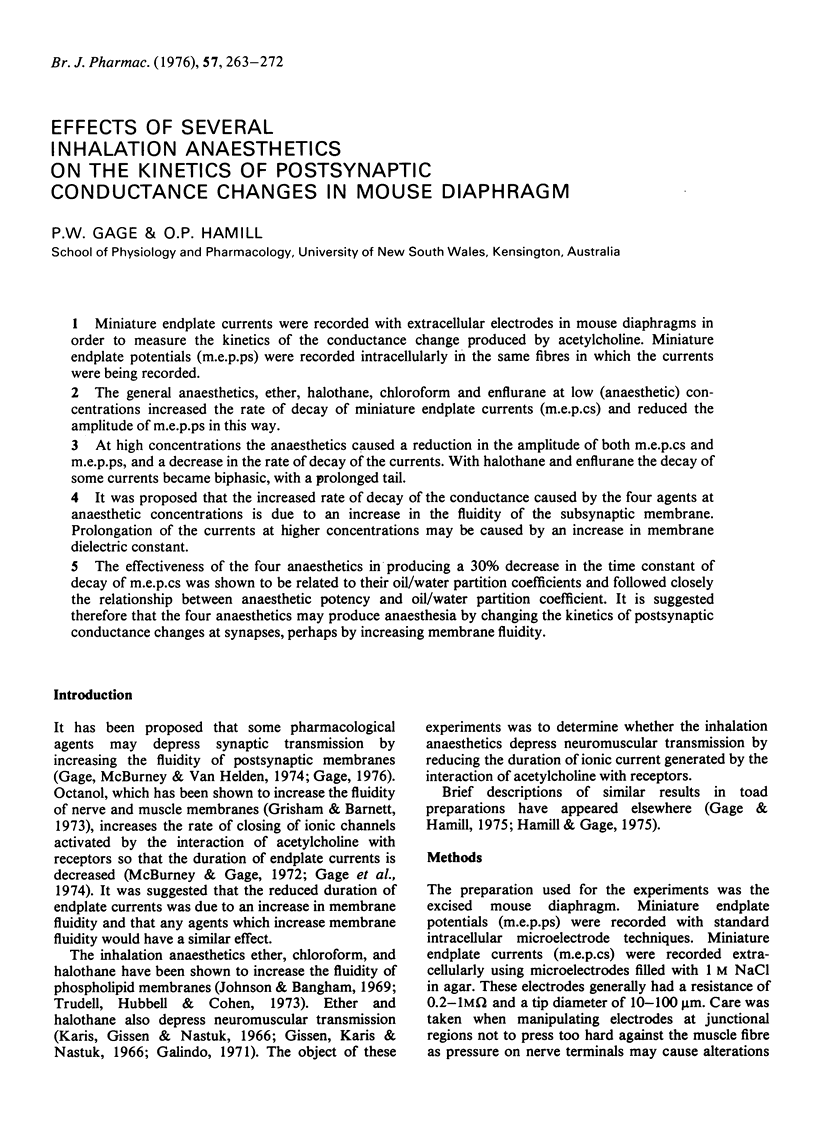
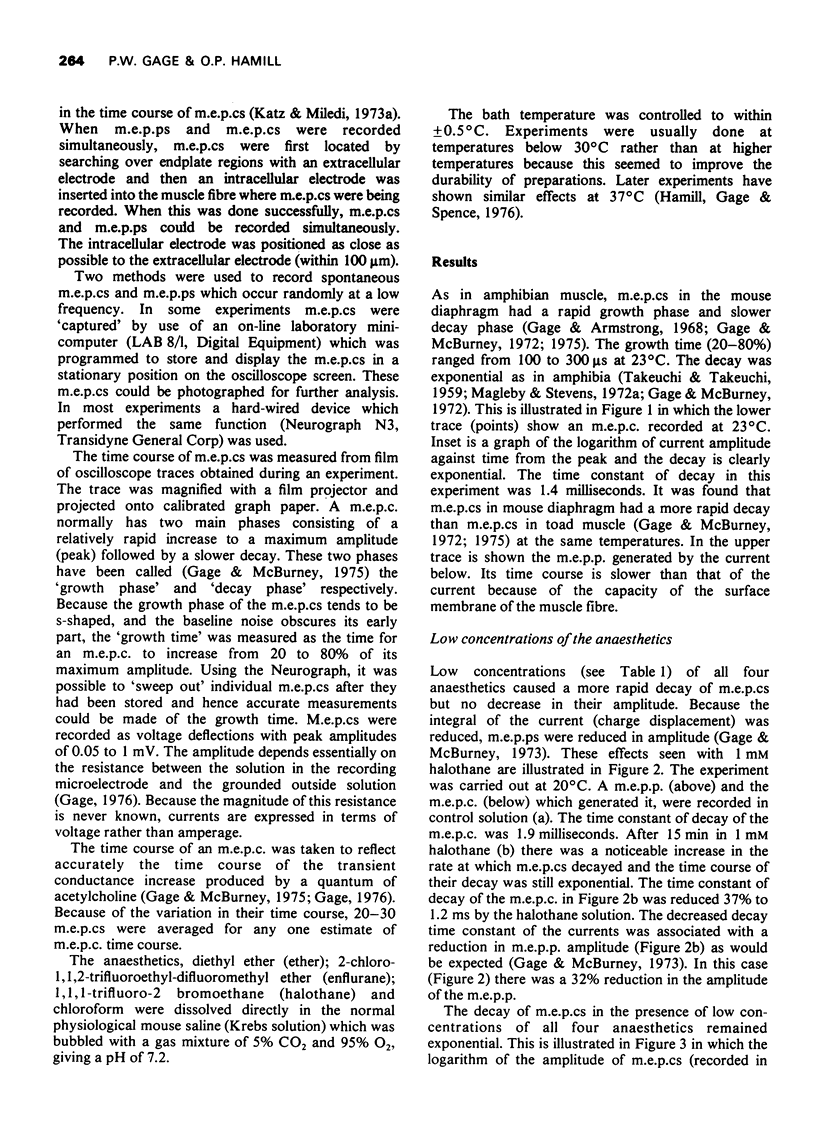
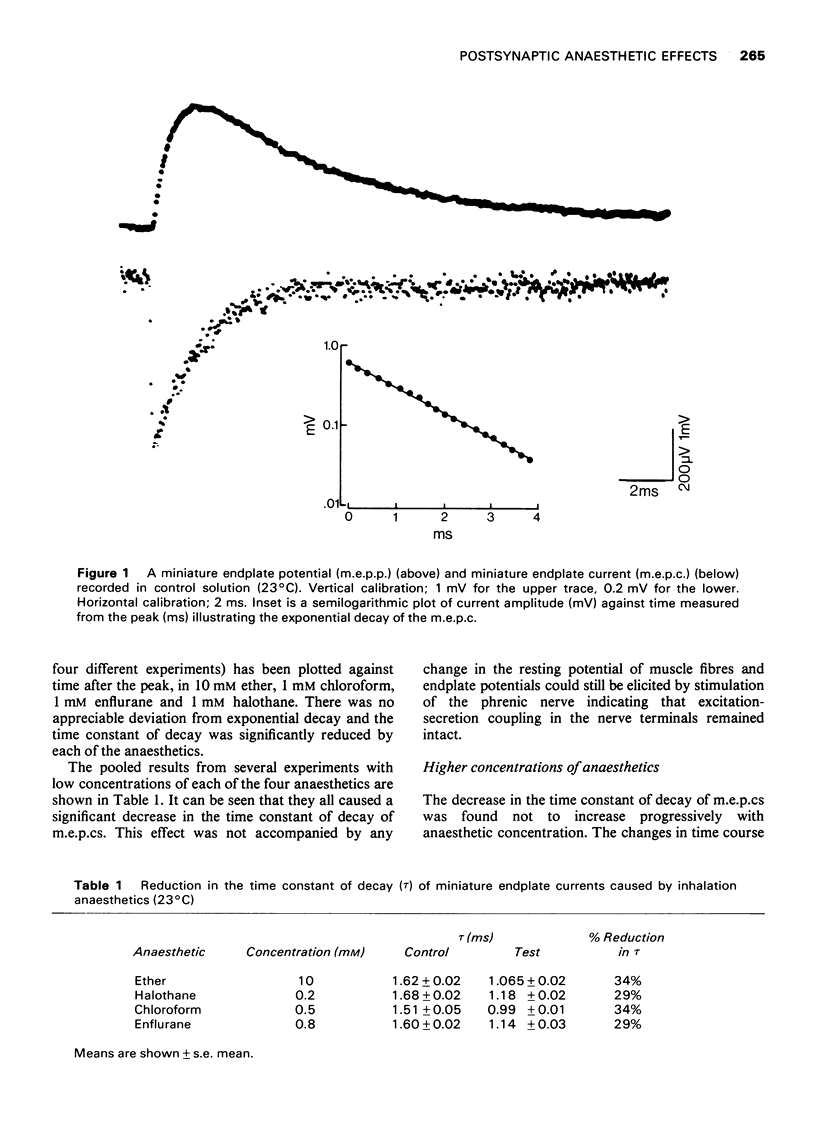
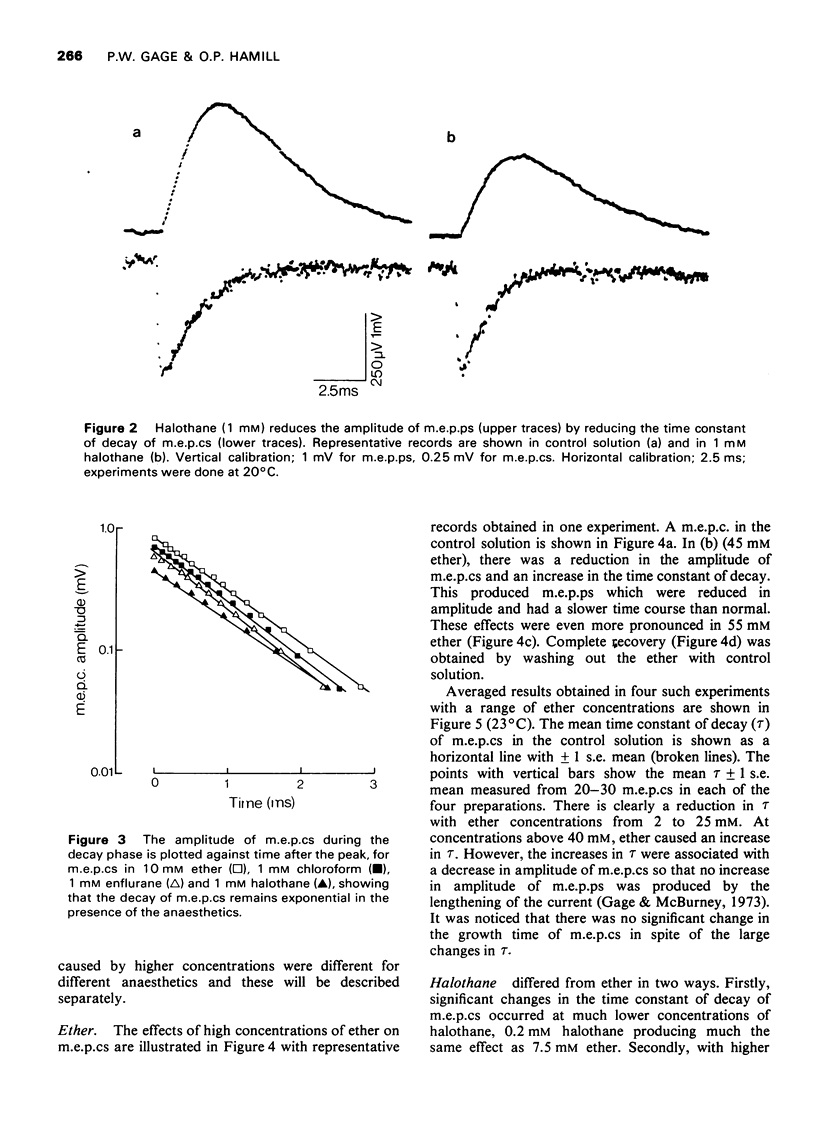
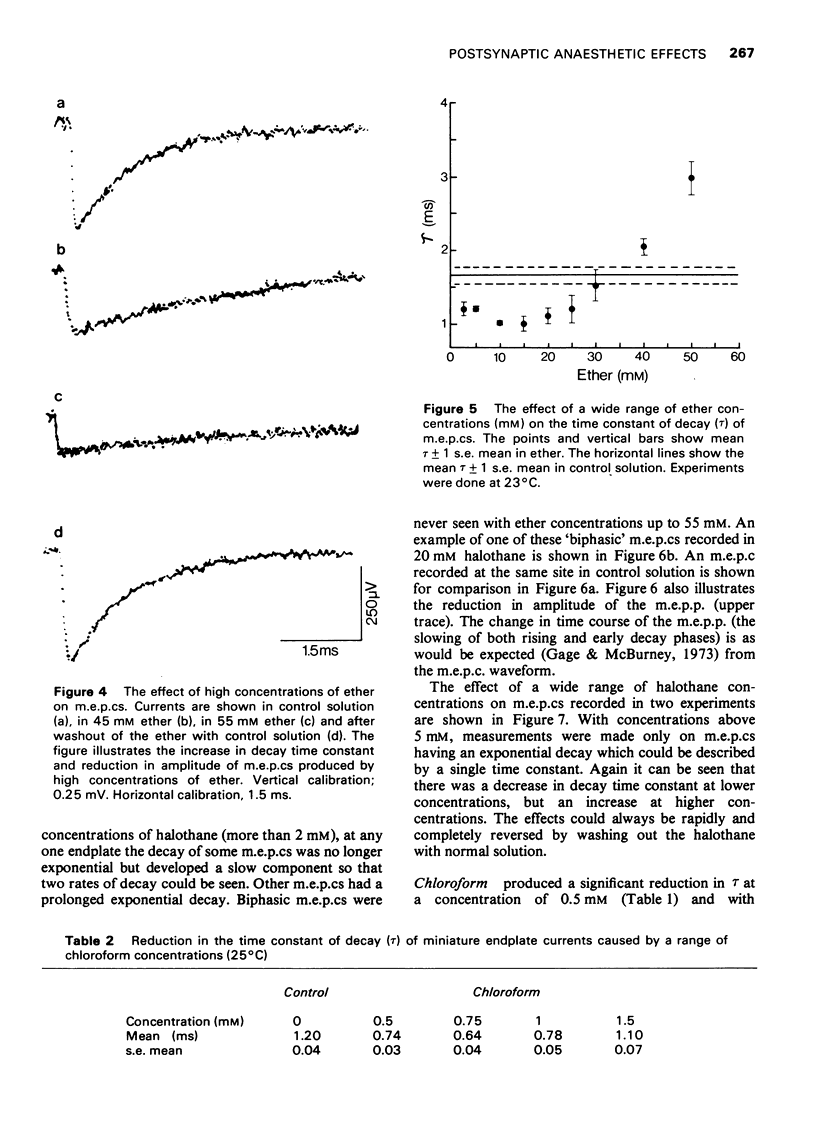
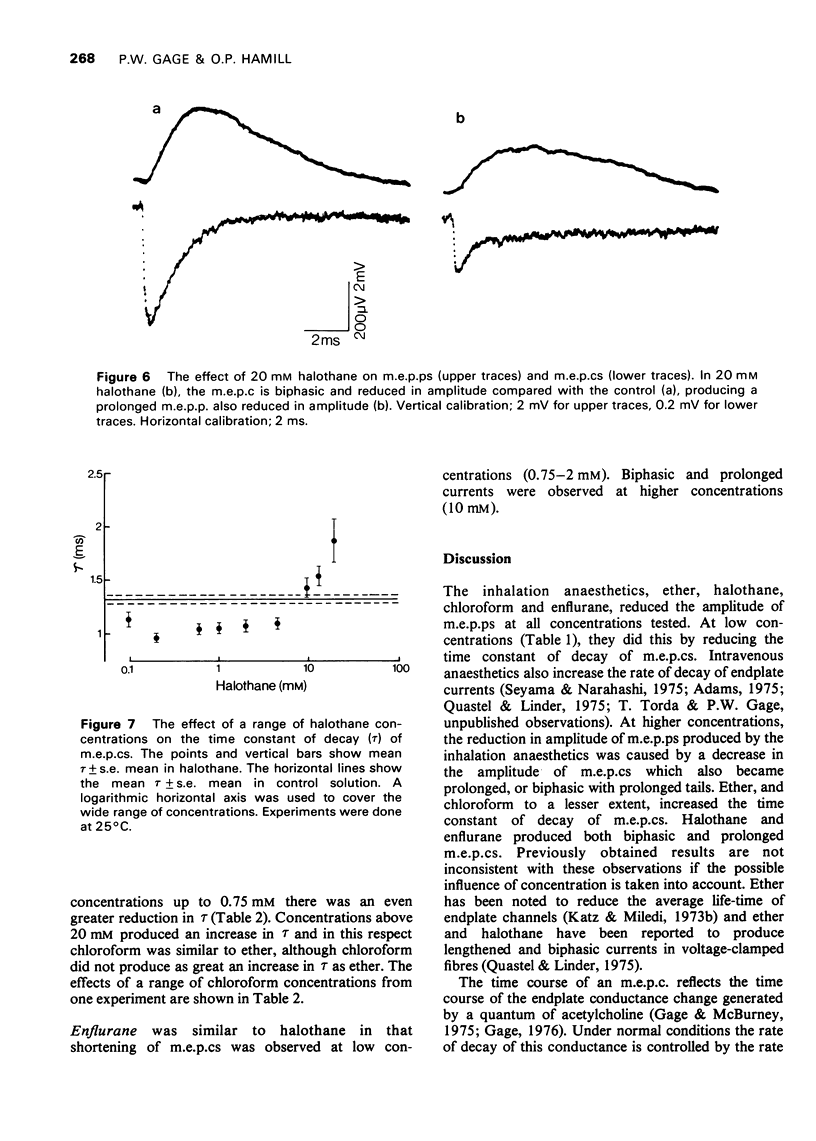
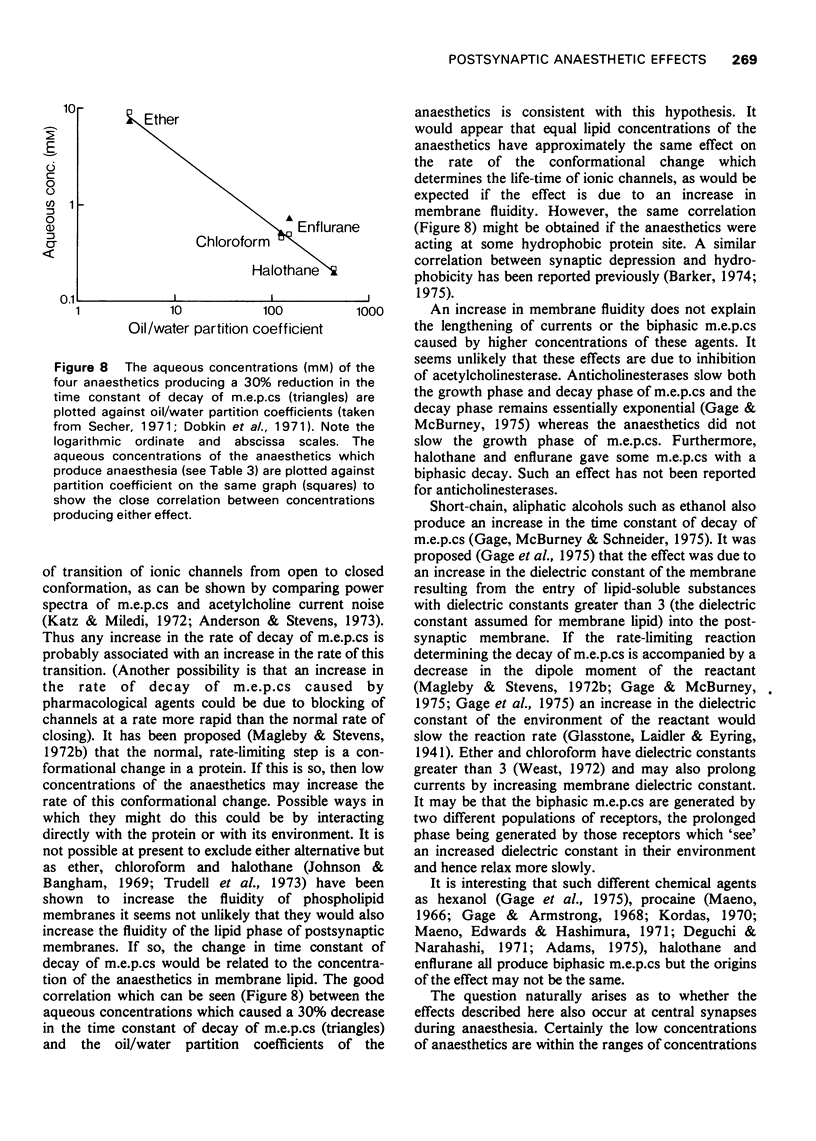
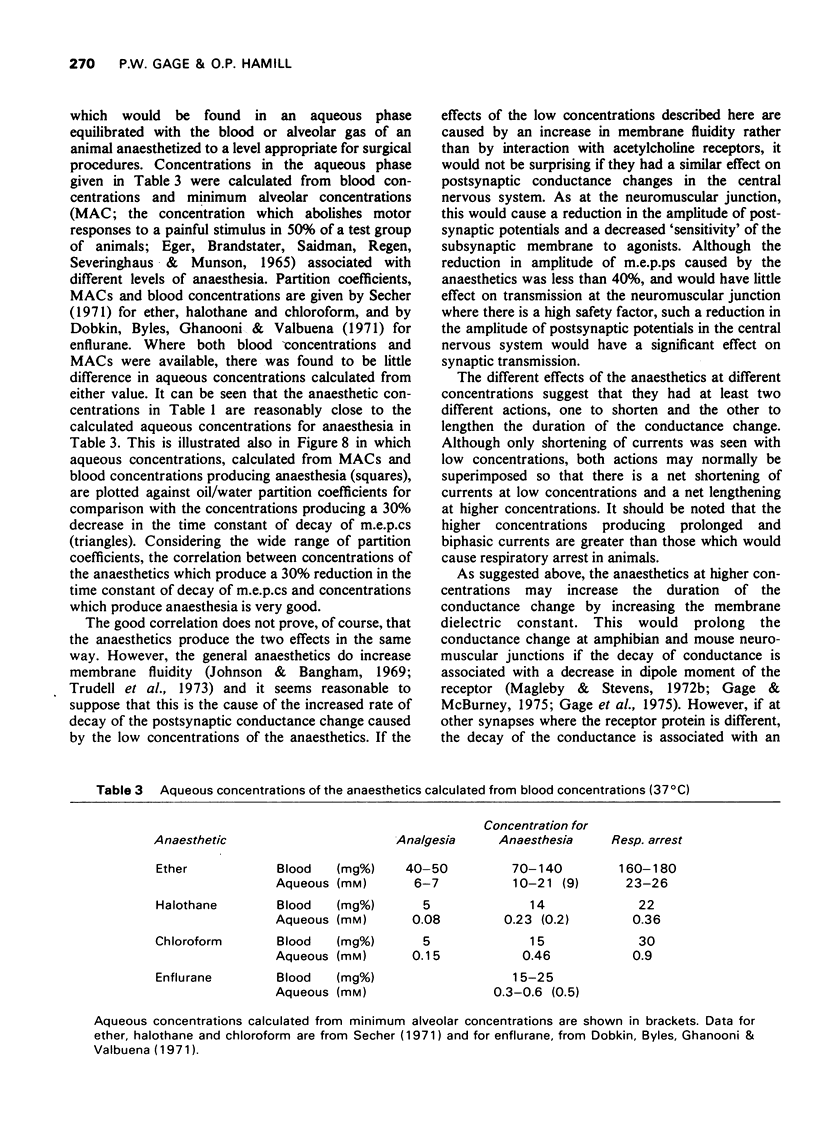
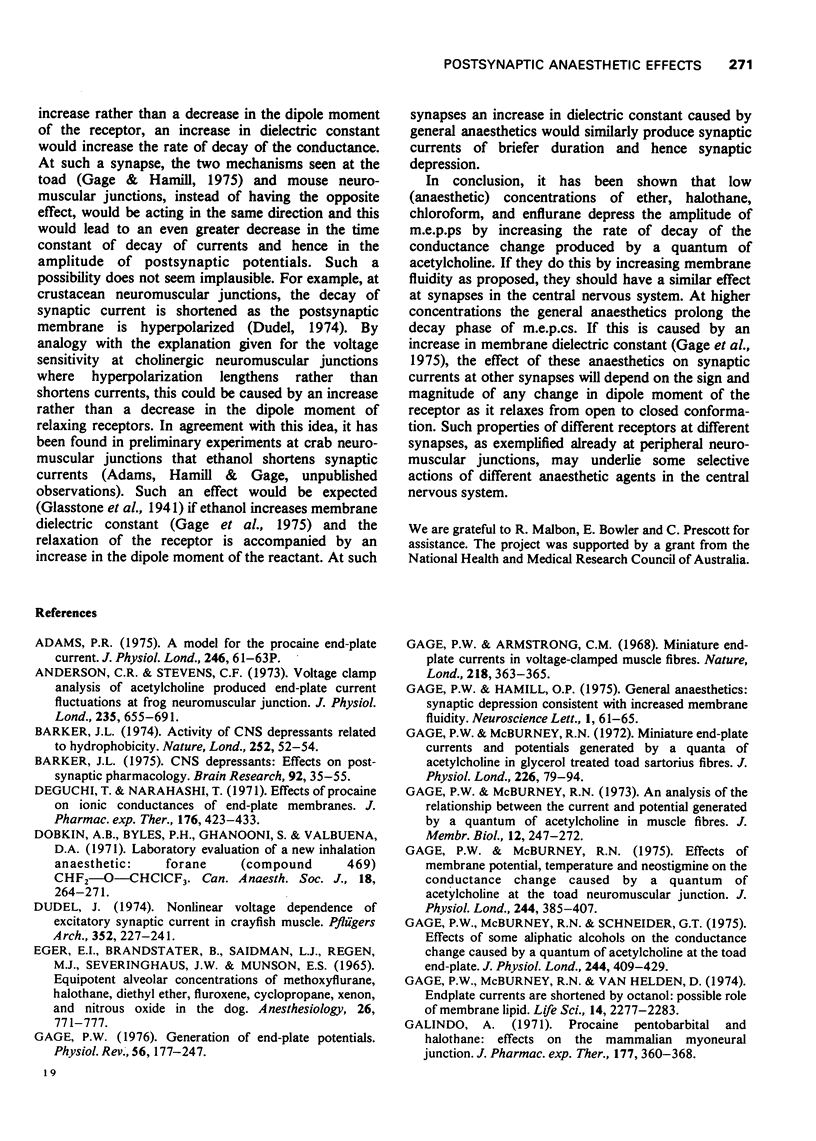
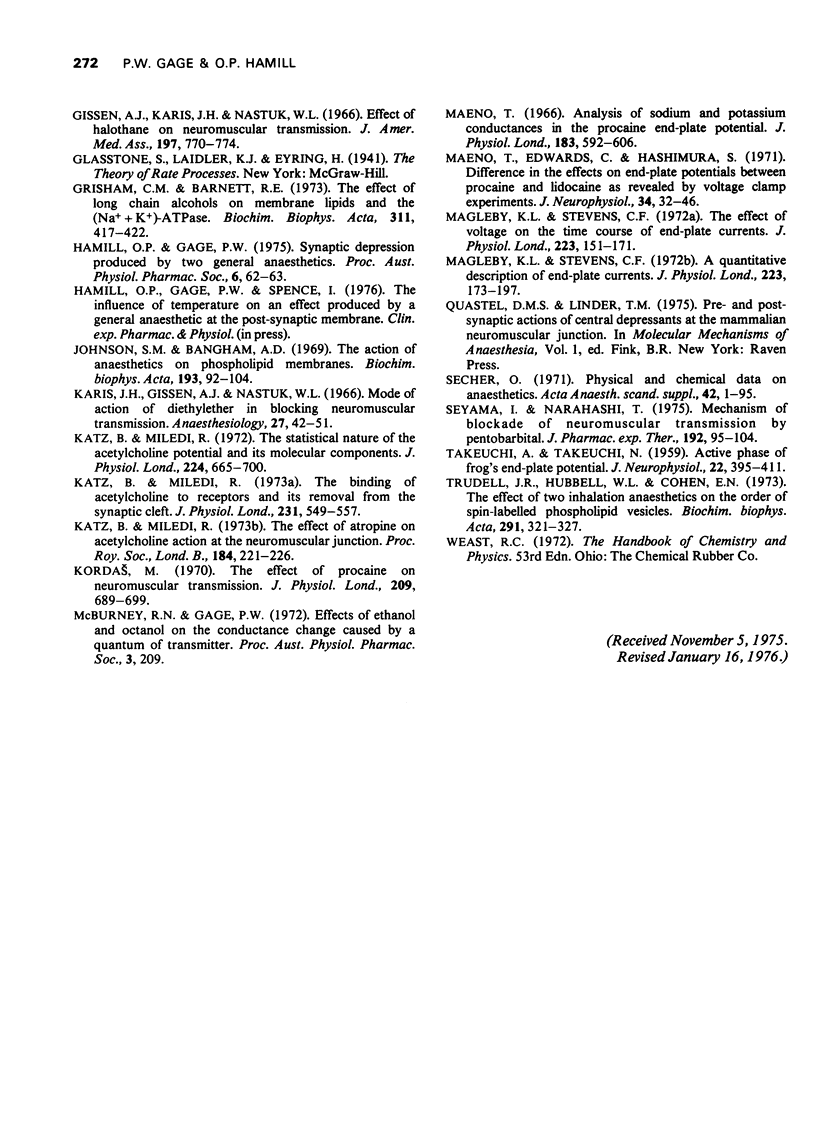
Selected References
These references are in PubMed. This may not be the complete list of references from this article.
- Adams P. R. A model for the procaine end-plate current. J Physiol. 1975 Mar;246(2):61P–63P. [PubMed] [Google Scholar]
- Anderson C. R., Stevens C. F. Voltage clamp analysis of acetylcholine produced end-plate current fluctuations at frog neuromuscular junction. J Physiol. 1973 Dec;235(3):655–691. doi: 10.1113/jphysiol.1973.sp010410. [DOI] [PMC free article] [PubMed] [Google Scholar]
- Barker J. L. Activity of CNS depressants related to hydrophobicity. Nature. 1974 Nov 1;252(5478):52–54. doi: 10.1038/252052a0. [DOI] [PubMed] [Google Scholar]
- Barker J. L. CNS depressants: effects on post-synaptic pharmacology. Brain Res. 1975 Jul 4;92(1):35–55. doi: 10.1016/0006-8993(75)90526-0. [DOI] [PubMed] [Google Scholar]
- Deguchi T., Narahashi T. Effects of procaine on ionic conductances of end-plate membranes. J Pharmacol Exp Ther. 1971 Feb;176(2):423–433. [PubMed] [Google Scholar]
- Dobkin A. B., Byles P. H., Ghanooni S., Valbuena D. A. Clinical and laboratory evaluation of a new inhalation anaesthetic: Forane (compound 469) CHF2-O-CHClCF3 (1-chloro-2,2,2-trifluoroethyl difluoromethyl ether). Can Anaesth Soc J. 1971 May;18(3):264–271. doi: 10.1007/BF03025461. [DOI] [PubMed] [Google Scholar]
- Dudel J. Nonlinear voltage dependence of excitatory synaptic current in crayfish muscle. Pflugers Arch. 1974;352(3):227–241. doi: 10.1007/BF00590488. [DOI] [PubMed] [Google Scholar]
- Eger E. I., 2nd, Brandstater B., Saidman L. J., Regan M. J., Severinghaus J. W., Munson E. S. Equipotent alveolar concentrations of methoxyflurane, halothane, diethyl ether, fluroxene, cyclopropane, xenon and nitrous oxide in the dog. Anesthesiology. 1965 Nov-Dec;26(6):771–777. doi: 10.1097/00000542-196511000-00012. [DOI] [PubMed] [Google Scholar]
- Gage P. W., Armstrong C. M. Miniature end-plate currents in voltage-clamped muscle fibre. Nature. 1968 Apr 27;218(5139):363–365. doi: 10.1038/218363b0. [DOI] [PubMed] [Google Scholar]
- Gage P. W. Generation of end-plate potentials. Physiol Rev. 1976 Jan;56(1):177–247. doi: 10.1152/physrev.1976.56.1.177. [DOI] [PubMed] [Google Scholar]
- Gage P. W., McBurney R. N. An analysis of the relationship between the current and potential generated by a quantum of acetylcholine in muscle fibers without transverse tubules. J Membr Biol. 1973;12(3):247–272. doi: 10.1007/BF01870004. [DOI] [PubMed] [Google Scholar]
- Gage P. W., McBurney R. N. Effects of membrane potential, temperature and neostigmine on the conductance change caused by a quantum or acetylcholine at the toad neuromuscular junction. J Physiol. 1975 Jan;244(2):385–407. doi: 10.1113/jphysiol.1975.sp010805. [DOI] [PMC free article] [PubMed] [Google Scholar]
- Gage P. W., McBurney R. N. Miniature end-plate currents and potentials generated by quanta of acetylcholine in glycerol-treated toad sartorius fibres. J Physiol. 1972 Oct;226(1):79–94. doi: 10.1113/jphysiol.1972.sp009974. [DOI] [PMC free article] [PubMed] [Google Scholar]
- Gage P. W., McBurney R. N., Schneider G. T. Effects of some aliphatic alcohols on the conductance change caused by a quantum of acetylcholine at the toad end-plate. J Physiol. 1975 Jan;244(2):409–429. doi: 10.1113/jphysiol.1975.sp010806. [DOI] [PMC free article] [PubMed] [Google Scholar]
- Gage P. W., McBurney R. N., Van Helden D. Endplate currents are shortened by octanol: possible role of membrane lipid. Life Sci. 1974 Jun 1;14(11):2277–2283. doi: 10.1016/0024-3205(74)90109-x. [DOI] [PubMed] [Google Scholar]
- Galindo A. Procaine, pentobarbital and halothane: effects on the mammalian myoneural junction. J Pharmacol Exp Ther. 1971 May;177(2):360–368. [PubMed] [Google Scholar]
- Gissen A. J., Karis J. H., Nastuk W. L. Effect of halothane on neuromuscular transmission. JAMA. 1966 Sep 5;197(10):770–774. [PubMed] [Google Scholar]
- Grisham C. M., Barnett R. E. The effects of long-chain alcohols on membrane lipids and the (Na++K+)-ATPase. Biochim Biophys Acta. 1973 Jul 6;311(3):417–422. doi: 10.1016/0005-2736(73)90322-2. [DOI] [PubMed] [Google Scholar]
- Johnson S. M., Bangham A. D. The action of anaesthetics on phospholipid membranes. Biochim Biophys Acta. 1969 Oct 14;193(1):92–104. doi: 10.1016/0005-2736(69)90062-5. [DOI] [PubMed] [Google Scholar]
- Karis J. H., Gissen A. J., Nastuk W. L. Mode of action of diethyl ether in blocking neuromuscular transmission. Anesthesiology. 1966 Jan-Feb;27(1):42–51. doi: 10.1097/00000542-196601000-00008. [DOI] [PubMed] [Google Scholar]
- Katz B., Miledi R. The binding of acetylcholine to receptors and its removal from the synaptic cleft. J Physiol. 1973 Jun;231(3):549–574. doi: 10.1113/jphysiol.1973.sp010248. [DOI] [PMC free article] [PubMed] [Google Scholar]
- Katz B., Miledi R. The effect of atropine on acetylcholine action at the neuromuscular junction. Proc R Soc Lond B Biol Sci. 1973 Nov 27;184(1075):221–226. doi: 10.1098/rspb.1973.0046. [DOI] [PubMed] [Google Scholar]
- Katz B., Miledi R. The statistical nature of the acetycholine potential and its molecular components. J Physiol. 1972 Aug;224(3):665–699. doi: 10.1113/jphysiol.1972.sp009918. [DOI] [PMC free article] [PubMed] [Google Scholar]
- Maeno T. Analysis of sodium and potassium conductances in the procaine end-plate potential. J Physiol. 1966 Apr;183(3):592–606. doi: 10.1113/jphysiol.1966.sp007886. [DOI] [PMC free article] [PubMed] [Google Scholar]
- Maeno T., Edwards C., Hashimura S. Difference in effects of end-plate potentials between procaine and lidocaine as revealed by voltage-clamp experiments. J Neurophysiol. 1971 Jan;34(1):32–46. doi: 10.1152/jn.1971.34.1.32. [DOI] [PubMed] [Google Scholar]
- Magleby K. L., Stevens C. F. A quantitative description of end-plate currents. J Physiol. 1972 May;223(1):173–197. doi: 10.1113/jphysiol.1972.sp009840. [DOI] [PMC free article] [PubMed] [Google Scholar]
- Secher O. Physical and chemical data on anaesthetics. Acta Anaesthesiol Scand Suppl. 1971;42:1–95. [PubMed] [Google Scholar]
- Seyama I., Narahashi T. Mechanism of blockade of neuromuscular transmission by pentobarbital. J Pharmacol Exp Ther. 1975 Jan;192(1):95–104. [PubMed] [Google Scholar]
- TAKEUCHI A., TAKEUCHI N. Active phase of frog's end-plate potential. J Neurophysiol. 1959 Jul;22(4):395–411. doi: 10.1152/jn.1959.22.4.395. [DOI] [PubMed] [Google Scholar]
- Trudell J. R., Hubbell W. L., Cohen E. N. The effect of two inhalation anesthetics on the order of spin-labeled phospholipid vesicles. Biochim Biophys Acta. 1973 Jan 26;291(2):321–327. doi: 10.1016/0005-2736(73)90485-9. [DOI] [PubMed] [Google Scholar]


